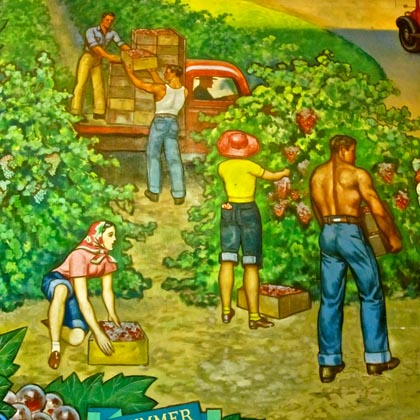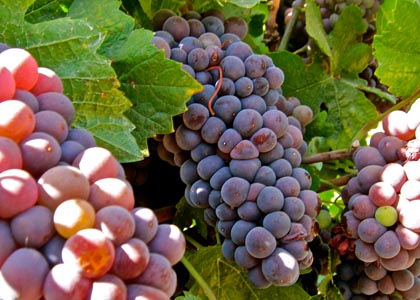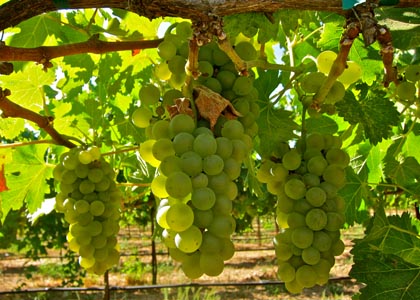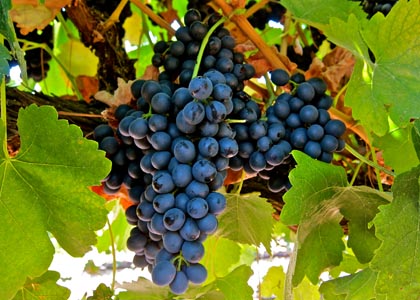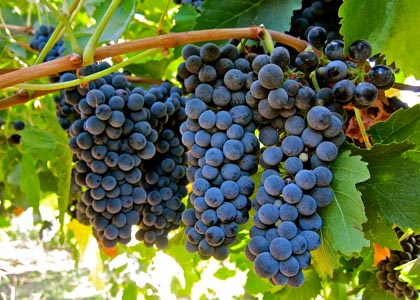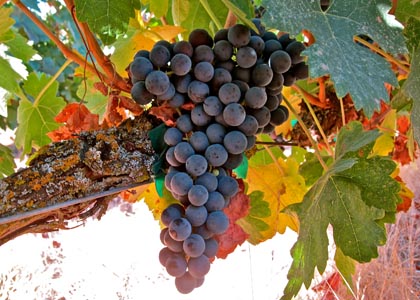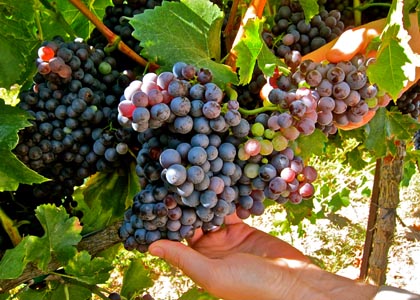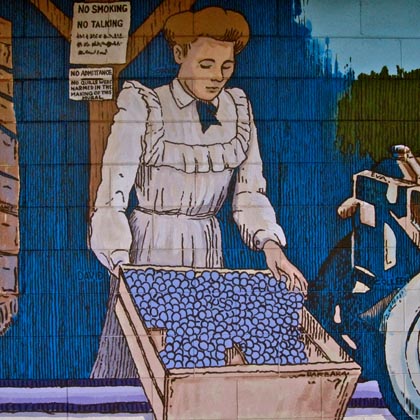Letters from Lodi
An insightful and objective look at viticulture and winemaking from the Lodi
Appellation and the growers and vintners behind these crafts. Told from the
perspective of multi-award winning wine journalist, Randy Caparoso.
Grape makes the wine, part 2
What a difference a grape makes, indeed…
Of all the major and cutting-edge varieties of Vits vinifera grown in California today, Syrah is the only wine grape Lodi doesn’t crush more of than any other region (Fresno beats out Lodi in Syrah acreage). Here are the sensory profiles on the other grapes of significance (other than those covered in our previous blogpost, What a Difference a Grape Makes) grown in the Lodi AVA.
WHITE WINE GRAPES
Sauvignon Blanc, Mohr-Fry Ranches
SAUVIGNON BLANC (also called Fumé Blanc in the U.S.)
Nose: Green melon aromas, often tinged by noticeably herbaceous (like cut grass, weeds, bell pepper, jalapeño, sweet pea, and other herbal associations) qualities, with quieter notes of minerals or flint (mildly minerally notes being more typical of French than New World grown Sauvignon Blancs), citrus fruits (especially lemon), and wildflowers. In New Zealand, a common descriptor is “gooseberry” (essentially, a green/tart melony perfume).
Palate: Usually dry and medium bodied; tends to have high acid (lemony tartness). The purest examples of Sauvignon Blanc of the world are the 100% varietal bottlings of France’s Loire River (especially those of Sancerre and Pouilly-Fumé). Those of Lodi are typically crisp and lush in fruitiness at the same time, with faintly herbaceous notes not unlike that of New Zealand.
Pinot Gris, Vino Farms
PINOT GRIS (called Pinot Grigio in Italy; Grauburgunder or Rülander in Germany)
Nose: A reddish gray skinned grape that invariably produces an interesting mix of floral (often like honeysuckle), fruity (sweet melon, apple or pear), and often minerally (like wet stones) aromas, sometimes with spice (musk with white pepper) and citrus (lime, sometimes lemon, Mandarin orange or tangerine) nuances; and when aged partially in oak (not an uncommon practice in France, Oregon and California, but unusual in Italy), enhanced by creamy/vanillin or honeyed qualities.
Palate: A wonderful, medium to full bodied varietal (12%-13% alcohol), usually finished close to bone dry (although rare, late picked styles from Alsace, called Vendange Tardive, can have perceptible sweetness). Acidity is usually medium (a lightly crisp tartness), definitely higher than Chardonnay but lower than Sauvignon Blanc. Both Oregon and California usually produce moderately crisp, medium bodied whites from this grape. Italian Pinot Grigios tend to be the lighter; and many extremely underrated bottlings come from Germany’s Baden region (bottled as Grauburgunder or Rülander).
Viognier, Vino Farms
VIOGNIER
Nose: Violet, honeysuckle, and sometimes lilac-like flower perfumes – typically striking in intensity — underscored by a mildly peppery spiciness, and lower levels of apricot, peach or tropical (like mango) fruitiness.
Palate: Classically a dry white of full body (13% alcohol or more) and low to moderate acidity (tends to be round rather than tart). Viognier is the classic stand-alone white grape of France’s Northern Rhône Valley (like Condrieu), but has adapted quite well to California regions like Lodi.
ALBARIÑO
Nose: Although not extensively planted even in its native Spain, Albariño is one of the few Spanish whites bottled as a varietal. In Lodi it has recently become a major grape; valued particularly for its culinary qualities (a terrific seafood white) as well as for its a prettily floral perfume (at times reminiscent of Viognier, and sometimes of Riesling) with its own minera, flint or stony accents, often with nuances of lime or lemon and stone fruits like peach or nectarine.
Palate: Medium body and usually vinified dry with medium/crisp to sometimes sharp acidity; refreshing sense of balance without being heavy, and afine texture that holds the grape’s floral fruitiness well.
RED WINE GRAPES
Syrah, Vino Farms
SYRAH (called Shiraz in Australia)
Nose: Somewhat exotic mix of sweet, rather floral (suggesting violet) perfumes, dark fruits (from blackberry to plum), and peppery spices; often enriched by pungently vanillin, smoky, or even dill-like oak-derived aromas, sometimes combining with the intense fruit aromas to give “roasting meat” qualities. In Australia (there, a national treasure) aromas tend to veer towards concentrated fruit, while in its native France (particularly the Northern Rhône) the Syrah qualities are more of perfumed spices (approaching sandalwood when merged with heavy toasted oak). In California Syrahs also tend to be floral like the French styles, yet with full bodied, ripe fruit qualities similar to Australians.
Palate: Like Zinfandel (although not nearly to extremes), Syrahs can vary from medium in body to big or astoundingly robust, while almost always are deeply pigmented. Tannin can be soft and round, but thick and muscle-bound at its fullest extent. Acidity is moderate across the board (although can be mildly zesty in France).
Petite Sirah, Ripken Vineyards
PETITE SIRAH (also known as Durif)
Nose: Not to be confused with Syrah, Petite Sirah is a red wine crossing of two varieties of Vitis vinifera, propagated by a Dr. Durif in 19th century France (where it is not grown commercially). In California the Petite Sirah nose is intensely spicy, suggesting cracked black peppercorn, with sometimes powerful, well ripened blackberry and/or blueberry aromatics.
Palate: Very full bodied almost as a rule, and significantly thickened with high tannin (in this sense, similar to Syrah) and phenolics (impenetrably black to purplish-blue pigmentations are not unusual); low in acid, but the sense of rich, peppery sweet fruitiness suggested in the nose can be more than enough to fill out the feel in the mouth.
Barbera, Borra Vineyards
BARBERA
Nose: Aromas ranging from red (raspberry and cherry) to blackberries (without the jamminess of, say, Zinfandel) in both its native Piemonte (where it is bottled as a varietal) and in California, where it has been long favored (yet underrated) for its savory food versatility (especially Italian/Mediterranean foods). In the best examples, Barbera gives nuances of violet, meat, suede and licorice in the nose; and use of oak (adding vanillin tones) can be variable.
Palate: Typically dark colored and medium in body (only occasionally a “big” wine), but more distinctly identifiable by its high, elevated acidity (downright sharp when out of control, yet still a good match for, say, dishes with tomato based sauces). Tannins can be moderate to fairly high (in both Italy and California), and so overall textures range from mildly zesty to hard, dry and angular.
Tempranillo, Bokisch Vineyards (Mokelumne River)
TEMPRANILLO
Nose: For such a noble grape, not the easiest aroma to describe – think of black fruits tinged with tar and red licorice, and tobacco leaf verging on smoked meats – which is why in its native Spain Tempranillo is often blended with other grapes (like Grenache and even Cabernet Sauvignon and Merlot) to fill it out. White oak aging (both American and French) is also a common component, enriching the nose with pungent vanilla and/or smoky qualities.
Palate: Typically lower acid combined with sappy fruit, medium to full bodies, and characteristically rounded tannins (even at strong levels) help Tempranillo and Tempranillo-based reds perform the neat trick of coming across as concentrated, even power-packed, yet invariably soft, almost succulent – classic “food” structures. In Spain, many examples (like in Rioja) can be fairly moderate, straightforward and easy drinking, while better examples (especially in Ribera del Duero) are as dense and elegant as any wines in the world. More and more, Tempranillo is emerging as one of Lodi’s finest grapes, producing richly textured, medium bodied red wines.
Grenache, Vino Farms
GRENACHE (called Garnacha in Spain; Cannonau in Sardinia)
Nose: When bottled as a red wine varietal (common in Australia and increasingly so in California) this classic Southern French grape is capable of sweet, lush strawberry/raspberry/cherry-like aromas with subtle, black peppery spice characteristics. These aromatic qualities are also typical of rosés made from Grenache (as in those of France’s Tavel and Bandol appellations). Although a workhorse grape in France, it is rarely a stand-alone as a red wine in that country; yet these red fruit aromatics are typical of Southern French reds blended with Grenache (usually in combination with spicier, violet-like Syrah and meaty/leathery Mourvèdre), as well as bottlings from Spain’s Priorat (where it is often blended with ultra-ripe Carignane), and Italy’s Sardinia (where Grenach is bottled as Cannonau).
Palate: Soft textured, lower acid, moderate to medium tannin grape; rarely going beyond medium weight or body, with the rare, saturated, “fruit bomb” exceptions from old-vine plantings in South Australia, Châteauneuf-du-Pape and Priorat.
